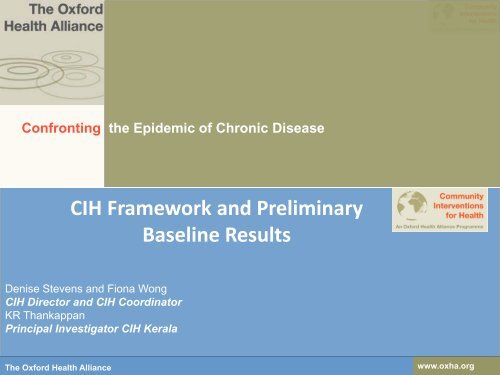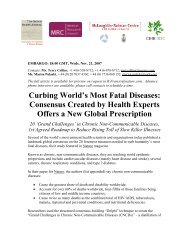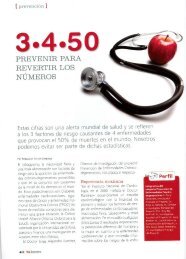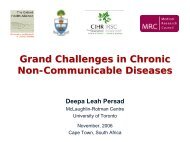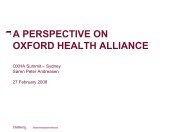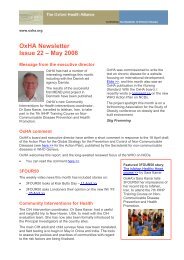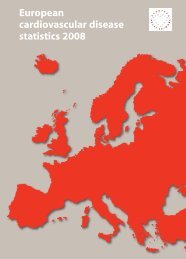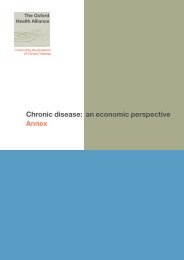CIH presentations OxHA summit 09 - Oxford Health Alliance
CIH presentations OxHA summit 09 - Oxford Health Alliance
CIH presentations OxHA summit 09 - Oxford Health Alliance
You also want an ePaper? Increase the reach of your titles
YUMPU automatically turns print PDFs into web optimized ePapers that Google loves.
Confronting the Epidemic of Chronic Disease<br />
The <strong>Oxford</strong> <strong>Health</strong> <strong>Alliance</strong><br />
The <strong>Oxford</strong> <strong>Health</strong> <strong>Alliance</strong><br />
<strong>CIH</strong> Framework and Preliminary<br />
Baseline Results<br />
Denise Stevens and Fiona Wong<br />
<strong>CIH</strong> Director and <strong>CIH</strong> Coordinator<br />
KR Thankappan<br />
Principal Investigator <strong>CIH</strong> Kerala<br />
www.oxha.org
The <strong>Oxford</strong> <strong>Health</strong> <strong>Alliance</strong><br />
The <strong>Oxford</strong> <strong>Health</strong> <strong>Alliance</strong><br />
Chronic Disease Risk Factors<br />
• Three risk factors cause four chronic diseases<br />
that cause over half of deaths worldwide.<br />
• The risk factors are:<br />
Lack of physical activity<br />
Unhealthy diet<br />
Tobacco use<br />
www.oxha.org
The <strong>Oxford</strong> <strong>Health</strong> <strong>Alliance</strong><br />
The <strong>Oxford</strong> <strong>Health</strong> <strong>Alliance</strong><br />
<strong>CIH</strong>: Part of the Solution<br />
• <strong>CIH</strong> – Community Interventions for <strong>Health</strong> –is the action<br />
arm of the <strong>Oxford</strong> <strong>Health</strong> <strong>Alliance</strong>.<br />
– <strong>CIH</strong> addresses both the risk factors for chronic disease and<br />
the barriers to change.<br />
– It is a multinational collaborative (developing and<br />
developed countries).<br />
– Researchers globally are working together to implement<br />
and evaluate interventions to address unhealthy<br />
diet, physical inactivity and tobacco use.<br />
‘Without knowledge action is useless and<br />
knowledge without action is futile’<br />
(Abu Bakr, c.573–674)<br />
www.oxha.org
The <strong>Oxford</strong> <strong>Health</strong> <strong>Alliance</strong><br />
The <strong>Oxford</strong> <strong>Health</strong> <strong>Alliance</strong><br />
<strong>CIH</strong> – Focus<br />
On the individual level the focus will be changes in<br />
knowledge, attitude, and behaviour as well as changes in<br />
physical/biological risk factors.<br />
On the local level, the focus will be on changes in policies and<br />
environments.<br />
Targeting structural (policy, environment, economic) changes<br />
as part of a comprehensive approach in<br />
neighbourhoods, schools, workplaces, and health centres is a<br />
primary strength of the <strong>CIH</strong> study.<br />
www.oxha.org
The <strong>Oxford</strong> <strong>Health</strong> <strong>Alliance</strong><br />
The <strong>Oxford</strong> <strong>Health</strong> <strong>Alliance</strong><br />
<strong>CIH</strong> Settings & Strategies<br />
• Four settings for a comprehensive intervention programme<br />
– School<br />
– Workplaces<br />
– <strong>Health</strong> centres<br />
– Neighbourhoods<br />
• Four strategies for change<br />
– Structural interventions (e.g.<br />
policy, environmental, economic)<br />
– <strong>Health</strong> education<br />
– Community coalition‐building<br />
– Media<br />
www.oxha.org
The <strong>Oxford</strong> <strong>Health</strong> <strong>Alliance</strong><br />
The <strong>Oxford</strong> <strong>Health</strong> <strong>Alliance</strong><br />
Comprehensive Approach<br />
<strong>CIH</strong> is about individual behavioural change through policy and environmental changes.<br />
Making the healthy choices the easy choices.<br />
www.oxha.org
The <strong>Oxford</strong> <strong>Health</strong> <strong>Alliance</strong><br />
The <strong>Oxford</strong> <strong>Health</strong> <strong>Alliance</strong><br />
<strong>CIH</strong>: Ecological Model<br />
www.oxha.org
The <strong>Oxford</strong> <strong>Health</strong> <strong>Alliance</strong><br />
The <strong>Oxford</strong> <strong>Health</strong> <strong>Alliance</strong><br />
www.oxha.org
• Community<br />
The <strong>Oxford</strong> <strong>Health</strong> <strong>Alliance</strong><br />
The <strong>Oxford</strong> <strong>Health</strong> <strong>Alliance</strong><br />
Types of Structural Interventions<br />
– <strong>Health</strong> assessments at community<br />
events<br />
– Affordable and accessible fruit and<br />
vegetables<br />
– Smoke‐free policies<br />
– <strong>Health</strong>y food choices at<br />
stores, restaurants and at events<br />
salt & fats & sugar<br />
– Safe routes for walking and bicycling<br />
(addressing active transport)<br />
Including addressing the built<br />
environment for where people shop, eat<br />
and play<br />
www.oxha.org
The <strong>Oxford</strong> <strong>Health</strong> <strong>Alliance</strong><br />
The <strong>Oxford</strong> <strong>Health</strong> <strong>Alliance</strong><br />
Types of Structural Interventions<br />
• Schools<br />
– Affordable healthy food<br />
and drink in cafeterias and<br />
vending machines<br />
salt & fats & sugar<br />
– 30 minutes of physical<br />
activity a day, three times<br />
per week<br />
– Advertisement‐free schools<br />
– Enhanced health curricula<br />
www.oxha.org
The <strong>Oxford</strong> <strong>Health</strong> <strong>Alliance</strong><br />
The <strong>Oxford</strong> <strong>Health</strong> <strong>Alliance</strong><br />
Types of Structural Interventions<br />
• <strong>Health</strong>care settings<br />
– Smoke‐free hospitals with<br />
healthy food options<br />
– Lifestyle‐tracking for<br />
patients<br />
– Incentives and training for<br />
providers to screen for and<br />
prevent chronic disease<br />
• Media<br />
– Information provided to<br />
families and children via<br />
radio and TV<br />
– Billboards, signs, posters to<br />
encourage healthy lifestyles<br />
www.oxha.org
The <strong>Oxford</strong> <strong>Health</strong> <strong>Alliance</strong><br />
The <strong>Oxford</strong> <strong>Health</strong> <strong>Alliance</strong><br />
Types of Structural Interventions<br />
• Workplace<br />
– <strong>Health</strong>y and affordable food in<br />
vending machines and cafeterias<br />
salt & fats & sugar<br />
– Use of healthier oils in food<br />
preparation<br />
– <strong>Health</strong> risk assessments and<br />
smoking‐cessation programmes<br />
– Incentives for participation in on‐<br />
site and off‐site physical activity<br />
– Point‐of‐contact prompts<br />
– Smoke‐free workplaces<br />
www.oxha.org
LEGEND<br />
Site: Sousse Tunisia<br />
University Hospital Farhat<br />
Hached<br />
Site: New Haven USA<br />
Yale University<br />
Site: Andover UK<br />
<strong>Oxford</strong> University<br />
Site: New Delhi India<br />
Centre for Chronic Disease<br />
<strong>CIH</strong> pilot sites<br />
Emerging <strong>CIH</strong> sites<br />
The <strong>Oxford</strong> <strong>Health</strong> <strong>Alliance</strong><br />
The <strong>Oxford</strong> <strong>Health</strong> <strong>Alliance</strong><br />
Site: A Delegacion in<br />
Mexico City<br />
InterAmerican Heart<br />
Foundation<br />
<strong>CIH</strong> Globally<br />
Site: Leicester, United<br />
Kingdom<br />
De Montefort University<br />
Site: Trivandrum District<br />
in the State of<br />
Kerala, India<br />
Centre for <strong>Health</strong> Science<br />
Studies of Sree Chitra<br />
Site: Hangzhou China<br />
Peking Univ. School of<br />
Public <strong>Health</strong> and<br />
Hangzhou CDC<br />
www.oxha.org
<strong>CIH</strong> EVALUATION METHODOLOGY<br />
The <strong>Oxford</strong> <strong>Health</strong> <strong>Alliance</strong><br />
The <strong>Oxford</strong> <strong>Health</strong> <strong>Alliance</strong><br />
www.oxha.org
Evaluation Methodology<br />
Process & Outcome Evaluation Design<br />
1. Intervention and Comparison Communities<br />
Intervention units selected as similar to comparison units on: SES,<br />
rural/urban status, and cultural/ethnic factors<br />
2. Pre‐ and Post Assessments (of individual and community) )(N~12,000/site)<br />
Individual Change & Impact of Structural Change<br />
– Surveys for behaviours as they relate to RFs, KAB, prevalence<br />
– Standard international survey translated and back‐translated<br />
– Site‐specific surveys allow the integration of important site questions<br />
– Physical and biological measurements<br />
3. Community Change: changes in policy and environment<br />
– Document review<br />
– Environmental scans<br />
– Key informant interviews<br />
– GIS mapping<br />
Implementation process evaluation (on‐going)<br />
The <strong>Oxford</strong> <strong>Health</strong> <strong>Alliance</strong><br />
The <strong>Oxford</strong> <strong>Health</strong> <strong>Alliance</strong><br />
www.oxha.org
The <strong>Oxford</strong> <strong>Health</strong> <strong>Alliance</strong><br />
The <strong>Oxford</strong> <strong>Health</strong> <strong>Alliance</strong><br />
Process Evaluation<br />
• What is the program intended to be?<br />
• What is delivered, in reality?<br />
• Where are the gaps between program design and delivery?<br />
• Examining factors such as……..<br />
Who: the program clients/recipients and staff<br />
What: activities, behaviors, materials<br />
When: frequency and length of the contact or intervention<br />
Where: the community context and physical setting<br />
How: strategies for operating the program or intervention<br />
*keeps sites on target and comprehensive<br />
www.oxha.org
• Height<br />
• Weight<br />
The <strong>Oxford</strong> <strong>Health</strong> <strong>Alliance</strong><br />
The <strong>Oxford</strong> <strong>Health</strong> <strong>Alliance</strong><br />
Physical & Biological Measures<br />
• Waist circumference<br />
• Hip circumference<br />
• Heart rate<br />
• Skin‐fold (if possible);<br />
and<br />
• Blood pressure<br />
• Fasting glucose<br />
• Random glucose<br />
• Total cholesterol<br />
• HDL<br />
• LDL<br />
• Triglycerides<br />
• Total cholesterol/HDL<br />
ratio<br />
www.oxha.org
The <strong>Oxford</strong> <strong>Health</strong> <strong>Alliance</strong><br />
The <strong>Oxford</strong> <strong>Health</strong> <strong>Alliance</strong><br />
Community Profile<br />
Component What tools will be used What information will it<br />
add?<br />
Current Policy<br />
Environmental scans Degree of policy<br />
Implementation and<br />
Practices<br />
Key Informant short<br />
surveys<br />
implementation and<br />
practices implemented<br />
without policy enactment<br />
Key informant<br />
interviews<br />
Media review<br />
Physical Aspects GIS mapping Representation of the<br />
community to assess<br />
relationships with physical<br />
and geographic attributes<br />
Policy Review Document review<br />
Key Informant short<br />
surveys<br />
Key informant<br />
interviews<br />
Current policies<br />
implemented, enforced, or<br />
being considered<br />
www.oxha.org
Schematic of Neighbourhood Assessment<br />
The <strong>Oxford</strong> <strong>Health</strong> <strong>Alliance</strong><br />
The <strong>Oxford</strong> <strong>Health</strong> <strong>Alliance</strong><br />
0.25 mile (or 400m) radius<br />
www.oxha.org
The <strong>Oxford</strong> <strong>Health</strong> <strong>Alliance</strong><br />
The <strong>Oxford</strong> <strong>Health</strong> <strong>Alliance</strong><br />
www.oxha.org
The <strong>Oxford</strong> <strong>Health</strong> <strong>Alliance</strong><br />
The <strong>Oxford</strong> <strong>Health</strong> <strong>Alliance</strong><br />
Evaluation Indicators<br />
• Intervention versus control and pre‐post:<br />
– Δ Behavioural determinants<br />
• e.g. consumption patterns<br />
– Δ Biometric measures<br />
• e.g. BMI, blood pressure<br />
– Δ Behavioural risk factor prevalence (self‐reported)<br />
• Policy implementation<br />
– e.g. environmental changes within community settings<br />
• Economic factors<br />
– e.g. affordability/availability/accessibility of healthy<br />
options<br />
www.oxha.org
End Products:<br />
The <strong>Oxford</strong> <strong>Health</strong> <strong>Alliance</strong><br />
The <strong>Oxford</strong> <strong>Health</strong> <strong>Alliance</strong><br />
End Products of <strong>CIH</strong><br />
– A comprehensive international database of<br />
intervention processes and outcomes<br />
– A best‐practice ‘roadmap’ of guidance to address<br />
chronic disease risk factors with adaptations for<br />
different settings<br />
– Research articles to further the field in risk factor<br />
reduction and chronic disease prevention<br />
www.oxha.org
The <strong>Oxford</strong> <strong>Health</strong> <strong>Alliance</strong><br />
The <strong>Oxford</strong> <strong>Health</strong> <strong>Alliance</strong><br />
Importance of <strong>CIH</strong><br />
• Comprehensive community interventions are rare<br />
(particularly in developing countries)<br />
• Structural interventions work<br />
• Need for best practice research<br />
• <strong>CIH</strong> includes an extensive evaluation component<br />
including both process and outcome evaluation<br />
• Cross cultural comparisons<br />
www.oxha.org
The <strong>Oxford</strong> <strong>Health</strong> <strong>Alliance</strong><br />
The <strong>Oxford</strong> <strong>Health</strong> <strong>Alliance</strong><br />
<strong>CIH</strong> Investigators: Pilot Initiative<br />
• <strong>OxHA</strong> Board & Stig Pramming, MD, Executive Director of the <strong>Oxford</strong> <strong>Health</strong> <strong>Alliance</strong><br />
• Christine Hancock, RN, Administrative Director, <strong>Oxford</strong> <strong>Health</strong> <strong>Alliance</strong><br />
• Beatriz Champagne, PhD, Executive Director of the InterAmerican Heart Foundation<br />
• KR Thankappan, MD, Additional Professor and Head of Achutha Menon Centre for <strong>Health</strong> Science Studies<br />
of Sree Chitra Tirunal Institute for Medical Sciences and Technology, Trivandrum, India<br />
• Liming Lee ,MD, Vice President for Chinese Academy of Medical Science & Peking Union Medical College<br />
and Professor at Peking University School of Public <strong>Health</strong><br />
• Jorge Ramírez Hernández, MD, PhD, Coordinator of Social and Economic Studies for Latin<br />
America, InterAmerican Heart Foundation, Mexico<br />
• Robert Baggott, Ph.D., Professor of Public Policy and Director <strong>Health</strong> Policy Research Unit, deMontefort<br />
University, Leicester, United Kingdom<br />
• Denise Stevens, PhD, Director of <strong>CIH</strong> Evaluation, President, MATRIX PHS (Evaluation Team)<br />
• Kathleen O’Connor, M.Ed, Co‐Director of <strong>CIH</strong> Evaluation (PhD candidate) Yale University School of<br />
Epidemiology & Public <strong>Health</strong> (Evaluation Team)<br />
Evaluation Team (additional)<br />
• Fiona Wong, MIH, Research Coordinator <strong>CIH</strong>, MATRIX PHS (Evaluation Team)<br />
• Brenda Fenton, Ph.D. Director of Research and Evaluation, MATRIX PHS (Evaluation Team)<br />
• Monika Doshi, MPH, Field Researcher, MATRIX PHS (Evaluation Team)<br />
• Karen Siegel, MPH, previously Data Manager <strong>CIH</strong> (currently <strong>Oxford</strong> University Research Fellow)<br />
www.oxha.org
<strong>CIH</strong> Advisory Board and Expert Panel<br />
Advisory Board Intervention Committee<br />
Diane Finegood, Executive Director, The CAPTURE Project, Canadian Samira Asma, Associate Director, Global Tobacco Control, CDC (US)<br />
Partnership Against Cancer (Canada)<br />
Diane Finegood, Executive Director, The CAPTURE Project, Canadian<br />
Martin McKee, Professor, London School of Hygiene and Tropical Partnership Against Cancer (Canada)<br />
Medicine (UK)<br />
William Haskell, Stanford University (US)<br />
K.M. Venkat Narayan, Professor, Emory University School of Public<br />
<strong>Health</strong> (US)<br />
Victor Matsudo, Agita Sao Paulo (Brazil)<br />
Pekka Puska, Director, Finland National Public <strong>Health</strong> Institute (Finland)<br />
Mark Woodward Professor of Medicine and Director, Biostatistics Core<br />
Department of Medicine The Mount Sinai Medical Center (US)<br />
<strong>OxHA</strong> Board Members Participating<br />
David Matthews, <strong>Oxford</strong> Centre for Diabetes, Endocrinology & Metabolism,<br />
UK<br />
Derek Yach, Director of Global Policy, PepsiCo, US<br />
The <strong>Oxford</strong> <strong>Health</strong> <strong>Alliance</strong><br />
The <strong>Oxford</strong> <strong>Health</strong> <strong>Alliance</strong><br />
Martin McKee, Professor, London School of Hygiene and Tropical<br />
Medicine (UK)<br />
Rachel Nugent, Center for Global Development (US)<br />
Michael Pratt, Centres for Disease Control and Prevention (US)<br />
Nigel Unwin, Institute of <strong>Health</strong> and Society (UK)<br />
Mark Woodward Professor of Medicine and Director, Biostatistics Core<br />
Department of Medicine The Mount Sinai Medical Center (US)<br />
www.oxha.org
Mexico<br />
India<br />
China<br />
United<br />
Kingdom<br />
The <strong>Oxford</strong> <strong>Health</strong> <strong>Alliance</strong><br />
The <strong>Oxford</strong> <strong>Health</strong> <strong>Alliance</strong><br />
<strong>CIH</strong> Baseline Progress<br />
Community<br />
Surveys<br />
(I) (C)<br />
School Surveys<br />
(I) (C)<br />
√ √ √<br />
<strong>Health</strong> Centres<br />
(I) (C)<br />
√ √ √ √ √ √<br />
√ √ √ √ √ √ √<br />
I=Intervention C=Control<br />
baseline begins September 20<strong>09</strong><br />
Work Places<br />
(I) (C)<br />
www.oxha.org
The <strong>Oxford</strong> <strong>Health</strong> <strong>Alliance</strong><br />
The <strong>Oxford</strong> <strong>Health</strong> <strong>Alliance</strong><br />
ENVIRONMENTAL SCAN<br />
www.oxha.org
The <strong>Oxford</strong> <strong>Health</strong> <strong>Alliance</strong><br />
The <strong>Oxford</strong> <strong>Health</strong> <strong>Alliance</strong><br />
Example of a Community Scan<br />
www.oxha.org
The <strong>Oxford</strong> <strong>Health</strong> <strong>Alliance</strong><br />
The <strong>Oxford</strong> <strong>Health</strong> <strong>Alliance</strong><br />
Mexico Baseline: 2008 Intervention Site<br />
What was scanned<br />
• 10 radii scan intervention and control<br />
• 293 stores/kiosk/fixed cart/mobile cart<br />
• 103 Restaurants or food services<br />
• Additional facility:<br />
– Street vendors, recreational facilities, parks and cultural<br />
house<br />
Student data<br />
• 2288 school children<br />
• Students were mostly 12 and 14 years<br />
www.oxha.org
FOOD ENVIRONMENT = shopping + eating<br />
The <strong>Oxford</strong> <strong>Health</strong> <strong>Alliance</strong><br />
The <strong>Oxford</strong> <strong>Health</strong> <strong>Alliance</strong><br />
www.oxha.org
Student Data: Fruit & Vegetable Consumption<br />
The <strong>Oxford</strong> <strong>Health</strong> <strong>Alliance</strong><br />
The <strong>Oxford</strong> <strong>Health</strong> <strong>Alliance</strong><br />
www.oxha.org
The <strong>Oxford</strong> <strong>Health</strong> <strong>Alliance</strong><br />
The <strong>Oxford</strong> <strong>Health</strong> <strong>Alliance</strong><br />
Example Radius: Places to Shop<br />
Mostly Sell fruits sell & high‐fat/salt/sugar<br />
Veg<br />
foods Other stores<br />
Other stores<br />
www.oxha.org
The <strong>Oxford</strong> <strong>Health</strong> <strong>Alliance</strong><br />
The <strong>Oxford</strong> <strong>Health</strong> <strong>Alliance</strong><br />
Opportunities for Structural Change<br />
Common store type<br />
Local stores (38%)<br />
Kiosks/stalls/ carts (25%)<br />
Convenience stores (14%)<br />
Mostly sell<br />
high‐fat/salt/sugar foods<br />
Local stores (82%)<br />
Kiosks/stalls/carts (37%)<br />
Convenience stores (80%)<br />
Opportunities<br />
↑ availability healthy<br />
food options<br />
www.oxha.org
The <strong>Oxford</strong> <strong>Health</strong> <strong>Alliance</strong><br />
The <strong>Oxford</strong> <strong>Health</strong> <strong>Alliance</strong><br />
Opportunities for Structural change<br />
Common store type Sell fruits and vegetables Opportunities<br />
Local stores (38%)<br />
Kiosks/stalls/ carts (25%)<br />
Convenience stores (14%)<br />
Local stores (14%)<br />
Kiosks/stalls/carts (60%)<br />
Convenience stores (13%)<br />
• Encourage vendors<br />
to promote sale of<br />
fruits and vegetables<br />
www.oxha.org
The <strong>Oxford</strong> <strong>Health</strong> <strong>Alliance</strong><br />
The <strong>Oxford</strong> <strong>Health</strong> <strong>Alliance</strong><br />
Combining Scan & School Data<br />
• Students were more likely to eat vegetables<br />
5+ days/wk in radii with more shopping<br />
opportunities for F+V<br />
• There was no relationship between students<br />
consumption of fruits 5+ days/wk by shopping<br />
opportunities.<br />
www.oxha.org
What Do We Know About the Food Environment?<br />
The <strong>Oxford</strong> <strong>Health</strong> <strong>Alliance</strong><br />
The <strong>Oxford</strong> <strong>Health</strong> <strong>Alliance</strong><br />
www.oxha.org
The <strong>Oxford</strong> <strong>Health</strong> <strong>Alliance</strong><br />
The <strong>Oxford</strong> <strong>Health</strong> <strong>Alliance</strong><br />
Opportunities For Eating (N=103)<br />
‘Americanized' Fast Food vs<br />
Others<br />
Americanized' fast food<br />
Mixed<br />
Other<br />
87%<br />
8% 5%<br />
www.oxha.org
The <strong>Oxford</strong> <strong>Health</strong> <strong>Alliance</strong><br />
The <strong>Oxford</strong> <strong>Health</strong> <strong>Alliance</strong><br />
Opportunities For Structural Change<br />
Consider focusing on non‐chain/local<br />
(“mom and pop”) restaurants to<br />
increase healthy food options<br />
<strong>CIH</strong> work with local restaurant associations<br />
Influence “demand” (e.g. address healthy<br />
alternatives e.g. Jicama with chili sauce)<br />
Is Americanized fast foods part of the<br />
story?<br />
www.oxha.org
Physical Activity Environment<br />
The <strong>Oxford</strong> <strong>Health</strong> <strong>Alliance</strong><br />
The <strong>Oxford</strong> <strong>Health</strong> <strong>Alliance</strong><br />
www.oxha.org
The <strong>Oxford</strong> <strong>Health</strong> <strong>Alliance</strong><br />
The <strong>Oxford</strong> <strong>Health</strong> <strong>Alliance</strong><br />
Student Data: Perception Of Physical<br />
Activity Environment<br />
www.oxha.org
The <strong>Oxford</strong> <strong>Health</strong> <strong>Alliance</strong><br />
The <strong>Oxford</strong> <strong>Health</strong> <strong>Alliance</strong><br />
Student Data: Active Transport<br />
• 49% of students walked or biked to school<br />
daily<br />
• in distance from school was associated<br />
with frequency of walking to<br />
school/bike<br />
• Students who live more than 30 minutes<br />
still walked or biked to school on some<br />
days.<br />
∴Feasible and acceptable for children to<br />
walk or ride bicycle to school (87% at least<br />
1+ days per week)<br />
www.oxha.org
The <strong>Oxford</strong> <strong>Health</strong> <strong>Alliance</strong><br />
The <strong>Oxford</strong> <strong>Health</strong> <strong>Alliance</strong><br />
Student Data: Sedentary Behaviour<br />
• 17% student have 7+ hours of sedentary<br />
habits (homework, screen time, and other<br />
sitting activities) during weekdays<br />
• 24% students have 7+ hours of sedentary<br />
habits during weekends (homework, screen<br />
time, and other sitting activities)<br />
www.oxha.org
The <strong>Oxford</strong> <strong>Health</strong> <strong>Alliance</strong><br />
The <strong>Oxford</strong> <strong>Health</strong> <strong>Alliance</strong><br />
Opportunities For Physical Activity<br />
• Places for physical activity<br />
– 6 parks<br />
– 17 recreational facilities (diverse types: gyms, dance<br />
studios, basketball courts, etc.)<br />
– 1 bike trail (ciclopista)<br />
– 1 large forest park (bosque)<br />
• Most indoor facilities have associated fees<br />
• Majority of facilities within 500 meters of public transport<br />
www.oxha.org
The <strong>Oxford</strong> <strong>Health</strong> <strong>Alliance</strong><br />
The <strong>Oxford</strong> <strong>Health</strong> <strong>Alliance</strong><br />
Opportunities For Structural Change<br />
•↑opportunities for<br />
physical activity both indoor/<br />
outdoors<br />
•↑ availability of free or low<br />
cost facilities<br />
www.oxha.org
The <strong>Oxford</strong> <strong>Health</strong> <strong>Alliance</strong><br />
The <strong>Oxford</strong> <strong>Health</strong> <strong>Alliance</strong><br />
Opportunities for Structural Change<br />
Develop school policies and support to:<br />
• Increase the amount of time spent engaged in<br />
physical activity<br />
• Use play grounds, equipment and space after‐<br />
school hours (e.g. team sports)<br />
www.oxha.org
TOBACCO ENVIRONMENT=Shopping and smoking<br />
The <strong>Oxford</strong> <strong>Health</strong> <strong>Alliance</strong><br />
The <strong>Oxford</strong> <strong>Health</strong> <strong>Alliance</strong><br />
www.oxha.org
The <strong>Oxford</strong> <strong>Health</strong> <strong>Alliance</strong><br />
The <strong>Oxford</strong> <strong>Health</strong> <strong>Alliance</strong><br />
Student Data About Tobacco Use<br />
•16% of students reported<br />
smoking in the past 30 days<br />
•Stores and “other people” were<br />
most common sources of<br />
cigarettes (~30% each)<br />
www.oxha.org
The <strong>Oxford</strong> <strong>Health</strong> <strong>Alliance</strong><br />
The <strong>Oxford</strong> <strong>Health</strong> <strong>Alliance</strong><br />
Opportunities to Purchase Tobacco<br />
58%<br />
Availability of Tobacco in Stores<br />
Has tobacco No tobacco<br />
Has "no sale to minors" sign Does not have "no sale to minor" sign<br />
42%<br />
34%<br />
66%<br />
www.oxha.org
The <strong>Oxford</strong> <strong>Health</strong> <strong>Alliance</strong><br />
The <strong>Oxford</strong> <strong>Health</strong> <strong>Alliance</strong><br />
Where Tobacco is Sold<br />
Stores selling tobacco<br />
Store selling tobacco<br />
with “no sale to minor”<br />
signs<br />
Other stores<br />
www.oxha.org
The <strong>Oxford</strong> <strong>Health</strong> <strong>Alliance</strong><br />
The <strong>Oxford</strong> <strong>Health</strong> <strong>Alliance</strong><br />
Opportunities For Tobacco Control<br />
Tobacco‐free environments<br />
•Of the 96 restaurants 16% had “no<br />
smoking” signs<br />
This varied across radii with 0%‐40%<br />
of restaurants having “no smoking”<br />
signs<br />
•No outdoor recreational facilities were<br />
designated as smoke‐free<br />
www.oxha.org
The <strong>Oxford</strong> <strong>Health</strong> <strong>Alliance</strong><br />
The <strong>Oxford</strong> <strong>Health</strong> <strong>Alliance</strong><br />
Opportunities for Structural Change<br />
Stores selling tobacco No sale to minor sign Opportunities<br />
•42 % sell tobacco •34% of stores that sell<br />
tobacco<br />
↑of stores with “no<br />
sale to minor” signs<br />
www.oxha.org
What Do We Know About the Tobacco Environment?<br />
The <strong>Oxford</strong> <strong>Health</strong> <strong>Alliance</strong><br />
The <strong>Oxford</strong> <strong>Health</strong> <strong>Alliance</strong><br />
www.oxha.org
Snap Shot: Availability of Tobacco vs F&V<br />
The <strong>Oxford</strong> <strong>Health</strong> <strong>Alliance</strong><br />
The <strong>Oxford</strong> <strong>Health</strong> <strong>Alliance</strong><br />
www.oxha.org
The <strong>Oxford</strong> <strong>Health</strong> <strong>Alliance</strong><br />
The <strong>Oxford</strong> <strong>Health</strong> <strong>Alliance</strong><br />
What Have We Learned?<br />
www.oxha.org
The <strong>Oxford</strong> <strong>Health</strong> <strong>Alliance</strong><br />
The <strong>Oxford</strong> <strong>Health</strong> <strong>Alliance</strong><br />
Summary Points<br />
• Important differences occur across radii with<br />
respect to the risk factors therefore targeted<br />
interventions are needed<br />
• More opportunities occur to buy unhealthy<br />
foods and tobacco than F&V<br />
• Students are sedentary therefore strategies<br />
are needed to encourage active transport and<br />
promote use of the built environment<br />
www.oxha.org
Benefits of the Environmental Scan<br />
• Environmental scan is value‐added in that it<br />
will:<br />
1. ↑ intervention effectiveness by identifying<br />
specific targets in the built environment;<br />
2. ↑ intervention efficiency through simultaneous<br />
assessment & planned interventions for the built<br />
environment to address multiple risk factors;<br />
3. capture the continuum of environments that<br />
people go through in their daily lives (home<br />
community, school, workplace, health care)<br />
The <strong>Oxford</strong> <strong>Health</strong> <strong>Alliance</strong><br />
The <strong>Oxford</strong> <strong>Health</strong> <strong>Alliance</strong><br />
www.oxha.org
Environmental Scan Operationalizes the<br />
Multifactorial Nature of Chronic Disease<br />
It Describes & Suggests Opportunities to Impact<br />
• Built environment<br />
• <strong>Health</strong>y food options & physical activity<br />
(balancing the energy In = energy out<br />
equation)<br />
• The continuum of environments where risk<br />
factors coexist together in our communities<br />
The <strong>Oxford</strong> <strong>Health</strong> <strong>Alliance</strong><br />
The <strong>Oxford</strong> <strong>Health</strong> <strong>Alliance</strong><br />
www.oxha.org
LESSONS LEARNED <strong>CIH</strong><br />
BASELINE<br />
The <strong>Oxford</strong> <strong>Health</strong> <strong>Alliance</strong><br />
The <strong>Oxford</strong> <strong>Health</strong> <strong>Alliance</strong><br />
www.oxha.org
The <strong>Oxford</strong> <strong>Health</strong> <strong>Alliance</strong><br />
The <strong>Oxford</strong> <strong>Health</strong> <strong>Alliance</strong><br />
Objectives of <strong>CIH</strong> Meeting<br />
• Share experiences of <strong>CIH</strong> baseline collection<br />
and intervention planning<br />
• Identify lessons learned<br />
• Strengthen partnerships across sites<br />
• Build linkages with global experts<br />
www.oxha.org
The <strong>Oxford</strong> <strong>Health</strong> <strong>Alliance</strong><br />
The <strong>Oxford</strong> <strong>Health</strong> <strong>Alliance</strong><br />
Lessons Learned I: Facilitators<br />
• The positive reputation of the<br />
university/PI’s research identity in<br />
the community made the<br />
introduction of the <strong>CIH</strong> study into<br />
the community smoother<br />
• Communities and schools very<br />
engaged in the process increased<br />
access to survey participants<br />
• Involvement of key government<br />
stakeholders in the project opened<br />
doors<br />
www.oxha.org
The <strong>Oxford</strong> <strong>Health</strong> <strong>Alliance</strong><br />
The <strong>Oxford</strong> <strong>Health</strong> <strong>Alliance</strong><br />
Lessons Learned II: Strengths<br />
• Use of and training on innovative technologies<br />
(e.g. environmental scan, fat analyzer)<br />
• Creation of new partnerships, “grafting” to<br />
existing partnerships, multiple university<br />
departments (including involvement of<br />
volunteers, students, community)<br />
• Educational opportunities provided for several<br />
Ph.D. students<br />
www.oxha.org
The <strong>Oxford</strong> <strong>Health</strong> <strong>Alliance</strong><br />
The <strong>Oxford</strong> <strong>Health</strong> <strong>Alliance</strong><br />
Lessons Learned III: Starting Up<br />
• Obtaining support & buy‐in from the key stakeholders<br />
(e.g. education, health, social welfare etc)<br />
– Example: Approximately 6 weeks of time invested<br />
to organize data collection (letters written, at least<br />
4 phone calls made for each setting and at least 3<br />
visits to each setting)<br />
• Giving stakeholders something they want (and which<br />
is within your realm of expertise to provide or<br />
leverage) in order to obtain buy‐in (e.g. One<br />
workplace requested EKGs in addition to the<br />
biomarker study).<br />
www.oxha.org
Lessons Learned IV: Starting Up (Cont.)<br />
• Organizing meeting with key stakeholders to make<br />
them “champions” for the project (Example; 2<br />
meetings with community leaders and important<br />
stakeholders (6 to 7 Panchayats) –with day long<br />
meetings of up to 50 )<br />
• Doing the “legwork” to establish face‐to‐face contact<br />
and minimize burden to settings (Example: It took<br />
approximately 6 visits to each school to gather<br />
baseline data ‐ initial meeting to introduce, then<br />
meet with teachers, distribute consent forms, data<br />
collection days<br />
The <strong>Oxford</strong> <strong>Health</strong> <strong>Alliance</strong><br />
The <strong>Oxford</strong> <strong>Health</strong> <strong>Alliance</strong><br />
www.oxha.org
The <strong>Oxford</strong> <strong>Health</strong> <strong>Alliance</strong><br />
The <strong>Oxford</strong> <strong>Health</strong> <strong>Alliance</strong><br />
Lessons Learned V: Challenges<br />
• Poor response rates among clinicians<br />
• Identity of non‐responders (particularly work<br />
place setting)<br />
• Stakeholders identify priorities outside scope of<br />
<strong>CIH</strong> (e.g. request for water and sanitation<br />
interventions)<br />
• Language:<br />
• Not all people involved in the project are able to<br />
understand the international protocols<br />
• Translation issues (literal and intended meaning)<br />
• Ensuring there is strong mechanism for quality<br />
control<br />
www.oxha.org
Lessons Learned VI: Challenges (Cont.)<br />
The <strong>Oxford</strong> <strong>Health</strong> <strong>Alliance</strong><br />
The <strong>Oxford</strong> <strong>Health</strong> <strong>Alliance</strong><br />
• Cultural belief that obesity is<br />
a sign of health and beauty<br />
• Impact of the economic<br />
transition interacting with<br />
cultural norms (e.g.<br />
hospitality around<br />
food, walking/biking to work<br />
linked to social status)<br />
• Biophysical measures (weight<br />
circumference women;<br />
equipment functioning<br />
challenges due to heat)<br />
www.oxha.org
Evaluation Team Observations: Strengths<br />
1. Dedicated researchers and institutions<br />
2. Selection of sites important, based on<br />
qualifications, status of academic<br />
institution, ability to function in team<br />
environments, commitment to comprehensive<br />
focus of <strong>CIH</strong>, ability and interest in working with<br />
communities<br />
3. International study ‐‐ communicating with<br />
diverse cultures enriches understanding and<br />
appreciation both personally and professionally<br />
and will ultimately strengthen the study<br />
The <strong>Oxford</strong> <strong>Health</strong> <strong>Alliance</strong><br />
The <strong>Oxford</strong> <strong>Health</strong> <strong>Alliance</strong><br />
www.oxha.org
Evaluation Team Observations: Strengths<br />
(Cont.)<br />
1. Successful establishment of management structures<br />
to handle the comprehensive approach/multiple<br />
settings<br />
2. Capacity building in communities and among new<br />
researchers<br />
3. Sharing of innovation (e.g. evaluation team and the<br />
environmental scan; fat analyzer) and spin off<br />
studies (e.g. nutritional labeling)<br />
4. Educational opportunities ‐ at least 1 Ph.D. and 2<br />
master’s theses currently underway<br />
The <strong>Oxford</strong> <strong>Health</strong> <strong>Alliance</strong><br />
The <strong>Oxford</strong> <strong>Health</strong> <strong>Alliance</strong><br />
www.oxha.org
Evaluation Team Observations: Challenges<br />
1. Survey development ‐ over 2 years in<br />
development, major challenge was addressing<br />
the balance between comprehensiveness and<br />
feasibility (hard for the evaluation team who<br />
saw the value of questions and what would be<br />
lost)<br />
2. Adaptation – multiple viewpoints, time to build<br />
consensus<br />
3. Communication – working with different time<br />
zones, understanding accents, different styles<br />
The <strong>Oxford</strong> <strong>Health</strong> <strong>Alliance</strong><br />
The <strong>Oxford</strong> <strong>Health</strong> <strong>Alliance</strong><br />
www.oxha.org


